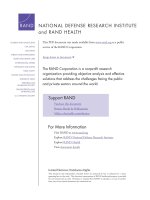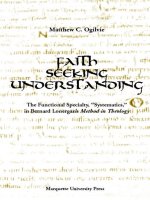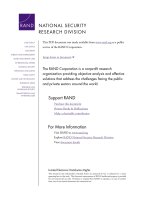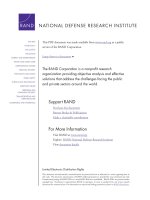Understanding islamforweb
Bạn đang xem bản rút gọn của tài liệu. Xem và tải ngay bản đầy đủ của tài liệu tại đây (420.22 KB, 28 trang )
Understanding Islam:
A Brief Introduction
By Alan D. DeSantis
Islam Today: Demographics
• There are an estimated 1.2 billion
Muslims worldwide
– Approximately 1/5th of the world's
population
– Growth without missionary efforts
• Where Do Muslims Live?
– Only 18% of Muslims live in the Arab world
– 20% are found in Sub-Saharan Africa
– 30% in the South Asian region of Pakistan,
India and Bangladesh
– The world's largest single Muslim
community is in Indonesia
• The Top 9: 1) Indonesia, 2) Pakistan, 3)
Bangladesh, 4) India, 5) Turkey, 6) Iran, 7)
Egypt, 8) Nigeria, and 9) China
The Islamic Map
Two Main Braches of Islam
• There are two main branches of Islam today
• Sunni recognize the male heirs of the first 4 elected
(according to Muhammad's instruction ) caliphs (or spiritual heads )
after Muhammad’s death
• Shiite recognize the decedents of only the 4th caliphs—Ali
(M’s son-in-law & cousin), the only true descendent of
Muhammad
•
In all other ways Sunni and Shiite are very similar
Understanding Muhammad:
His Life and Times
The Life of Muhammad:
The early years
• Muhammad was born in Mecca around the
year 570 (A city of western Saudi Arabia)
• Mecca was not a kind, friendly culture
• These tribes all worshiped many different
gods (polytheistic)
• Muhammad began working as a merchant
and was known for his trustworthiness
• Muhammad and Khadija (wife) had 4
daughters and 2 sons
The Life of Muhammad:
The Visions and the Message
• Fifteen years after his marriage, he began to have visions and
hear mysterious voices
• When Muhammad was about 40 years old an angel appeared
to him in the form of a man
• This revelation was soon followed by others about the one true
God
– The key message:
• Unlike Jesus (who Christians believe was God's son) Muhammad was
a mortal, albeit with extraordinary qualities
• He preached a strong social justice message about equality
and poverty
The Life of Muhammad:
The Trouble
• Muhammad slowly began to attract some
followers, most of them young and of modest
social standing
• The ruling elite feared Muhammad and his
followers and began to persecute them
• Muhammad's prestige grew much larger after
the war and the subsequent surrender of the
Meccans
The Life of Muhammad:
Conclusion
• Muhammad's life was cut short by his
sudden death on June 8, 632 at about
60 years old
• Within 100 years, Islam spread across
the world, occupying more territory than
the Roman Empire
Koran (or the Qur'an)
Koran (or the Qur'an)
• Introduction
– God's revelations to
Muhammad
• The Creation of the Book
Koran (or the Qur'an)
• The Content
– A) The Koran as a book is
comparable in length to the Gospels
– B) Chapters of the Koran follow in
descending order of length
– C) Many commandments, few stories
– D) Introduced life after death and
heaven & hell (divine reckoning)
Muslims view other religions:
• Muslims believe that God had previously
revealed Himself to the earlier prophets
of the Jews and Christians
• Muslims therefore accept the teachings
of both the Jewish Torah and the
Christian Gospels
Moses
• They believe that Islam is the perfection
of the religion
The Five Pillars
•
•
The believer worships God directly without the
intercession of priests or clergy or saints.
The believer's duties are summed up in five simple
rules, the so-called Five Pillars of Islam:
•
1) Belief
•
2) Worship
– A) Worship God five times a day — at dawn, noon,
mid-afternoon, sunset, and nightfall.
– B) All males gather together on Friday for the noon
prayer and listen to a sermon by the leader of the
community.
The Five Pillars
• 3) Fasting
• 4) Almsgiving
• 5) Pilgrimage
The Brief History of the
Islamic World
(in 4 parts)
I. The Spread of Islam
• During the 8th Century (700s AD), one hundred years after M’s
death, Islam spreads through three continents
– The empire spread from Spain to the edge of India
Map of the expansion of Islam. 7th-8th centuries
II. The Spread of Islam
and the first Renaissance:
• Baghdad (Iraq) became the center of
learning and innovation
• While Europe was the Dark Ages:
– A)
– B)
– C)
II. The Spread of Islam
and the first Renaissance:
• The Muslims:
– 1) Translated
– 2) Invented
– 3) Understood
– 4) Developed
– 5) Utilized
– 6) Refined
– 7) Advanced
III. Christian vs. Muslim (The Crusaders)
• 11th century (1,000 AD), however, Christians and
Muslims were headed for a crash course.
• No one thought that the Crusaders would ever
come from Barbaric Europe
• The rest of the Islamic world outside of the Holy
City went on as usual
• 1186 AD, Saladin raided Jerusalem and wiped
out the Crusaders
The Crusades
IV. The Ottoman Empire
•
The Ottoman Turkish Empire was an imperial
power, centered around the borders of the
Mediterranean Sea, that existed from 1299 to 1922
•
In the 16th and 17th centuries, the Ottoman Empire
was among the world's most powerful political
entities
•
The dissolution of the Ottoman Empire was a
consequence of WWI when Allied forces, eventually
defeated Ottoman forces in the Middle East
Fundamentalism
vs.
Liberalism
in Today’s Islamic States
Liberalism in Islam
• What happened to this once
intellectual/enlightened empire?
– Is today the Islamic Dark Ages?
• Most say it was the rise of Fundamentalism
– 1) Church is State
– 2) Literal Interpretation of sacred Text
– 3) No secular creativity or ideas
– 4) Progress in bad
• Liberal movements seek a new Renaissance
Liberalism in Islam
• 1) Human rights
• 2) Feminism
–
–
–
–
–
A) Reject
B) Reject
C) Promote
D) Promote
E) Reject









